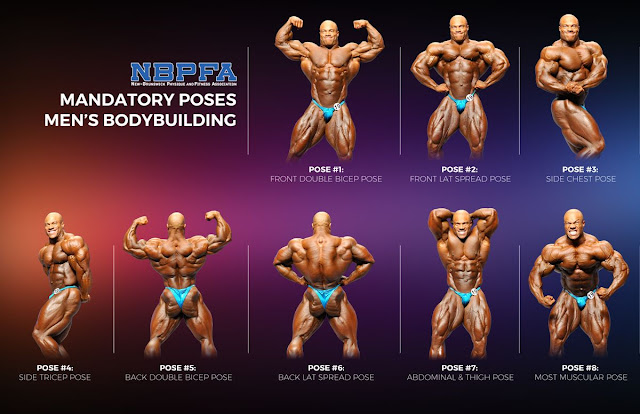What Is The Lat Spread?
Some people might be unfamiliar with the term, but it's a popular technique that is used during bodybuilding competitions. When an individual has his arms outstretched like wings and his hands on his knees, this is referred to as the lat spread.
In general, the goal of this competition pose is to show off as much of your physique in one pose than you can in any other.
Both the front spread and rear spread are usually compulsory poses in bodybuilding competitions so it is worth knowing how to do them properly for maximum points.
How to do the front lat spread
- Stand with your feet at shoulder width for stability. Point your toes outwards in a v shape and bend at the knee to contract the quadriceps.
- Make a fist with both hands but stick your thumbs up.
- Place your thumbs at the bottom of the rib cage and rotate your hands outwards.
- Spread your lats at the same time as pulling your shoulders back and sticking your chest out.
- If you have the physique, this should demonstrate the V taper.
- If you have a thicker waist, you will need to really push the chest out to give your lats the illusion of width.
- Tilt forward slightly and stick your glutes out so that you can flex the maximum amount of muscle in one pose.
When performing the lat spread pose, make sure that your feet are shoulder-width apart and your knees are bent to 90 degrees. Then, press your palms into the ground and lift your torso up off the ground until you're in a standing position.
Keep your back straight and your abdominals pulled in as you hold this position for 30 to 60 seconds.
How to do the rear spread
- The rear spread is essentially the same as a front spread but facing away from the judges to showcase the muscles in your back.
- Pose as you would for a standard front spread but with your back to the judges
- Contract the lats by pushing your shoulder blades together and squeezing.
- As you move your elbows out in front of you, this spreads the shoulder blades and showcases the width of your lats.
- Use this pose to flex your glutes, calves and hamstrings for maximum results.
How can I improve my lat spread?
To improve your front spread you will need to focus on exercises that improve your V taper. This would include wider lateral delts, taller traps, wider lats and for the benefit of the rear spread, a developed lower back.
If the issue is a thick waistline, you can remedy this through diet and limiting exercises that develop the abdominals and obliques.
To build muscles for a better lat spread, we have listed the best movements below.
Exercises for fuller lats
Bent over rows
Bent over rows are probably the best mass builder for the lats. They allow you to train with intensity and volume whilst also activating muscles in the core and lower back. The rear delts also support the movement making it ideal for improving your lat spread.
Lat pulldowns
Lat pulldowns are a great way of isolating the lats and defining them. The common theory seems to be that using a wide grip will add width to the lats but science is now starting to prove that is not the case.
Using a narrow grip adds just as much width but also vastly improves the thickness of the lats.
Cable rows
Cable rows with a wide grip bar allow you to really squeeze the shoulder blades together and connect with the lats. Use a slightly lighter weight for cable rows and focus on a slow, controlled movement. This is a great movement for maximising time under tension on the lats.
Exercises for taller traps
Deadlift
The deadlift is great for the entire posterior chain so it is a must-do to achieve a good lat spread pose. To develop the traps with a deadlift, you are going to have to go heavy.
The stress on the CNS forces your body to temporarily release IGF-1 and testosterone after a heavy deadlift so, even though they may fatigue you during a workout, they will assist growth in all areas.
Shrug
Shrugs are a great way to isolate the traps. Use a heavy barbell or smith machine for the best results. It is a good idea to wear a lifting belt and wrist straps. If you go heavy, your grip will give out long before your traps!
A good way to attack the traps with shrugs is to perform 5-6 reps with a slow movement, holding the contraction for 8 seconds and squeezing the traps. Immediately afterwards, pump the bar up and down for 5-6 reps to really fatigue the muscle. Class this as one set and perform 2-3 more sets.
Lateral shrugs
Lateral shrugs are performed o a row machine or cable pulley. Set up as you would for a cable row ut with the pulley on a low pin.
Attach the v-bar or straight bar and grab it with an overhand grip.
Without flexing at the elbow, shrug the bar towards you and squeeze the traps. Hold the squeeze for a few seconds before relaxing. Repeat this for 10-12 reps and 3-4 sets.
Don't go too heavy on this one. For maximum hypertrophy, focus on good form and a controlled movement. Feel a connection with the traps and really squeeze it at the top of each rep.
Rack pulls
Rack pulls are a great way of developing the traps without taxing the hamstrings and lower back. As you are not lifting the weight from the ground, you can strap up and go really heavy with these.
After a few sets of rack pulls you can really feel the burn in your traps.
Exercises for Lower back
Deadlifts
Deadlifts have made the list again as there is no better exercise for developing the posterior chain. Regular deadlifts will add strength and mass to the spinal erectors giving you a defined lower back.
If you want to train the lower back with a lighter weight and take assisting muscles out of the equation, consider stiff leg deadlifts.
Hyperextensions
Hyperextensions are a great functional movement but when you add weight, they are also great for building muscle mass in the lower back.
Exercises for wider delts
Shoulder press
The shoulder press is widely considered a front delt exercise but it also highly activates the lateral delts and to a lesser extent, the rear delts. Go as heavy as you can with the shoulder press whether it be on a machine, on a bench with dumbbells or in a rack with a barbell.
Another great shoulder press movement to consider is the Arnold press. When performed correctly, these can be great fr developing the lateral delts and adding width to the shoulders.
Lateral raises
Lateral raises are the best movement that you can use to add mass to the side delts. It is generally used as an accessory movement after a heavy pressing session but by supersetting them with front or rear delt raises, you can really tax the shoulders.
Upright rows
Upright rows are not only great for building the lateral delts but also help with rear delt and trap development.
Conclusion
We hope that you have found this article useful. We have covered the different types of lat spreads, why it is important to develop them and how to improve them in the gym.
If you are looking for a FREE hypertrophy training program to get you to the next level in bodybuilding, check out our HyperGrowth strategy by clicking on the link below.
FREE TRAINING PROGRAMS
Gymenix offers a selection of free training programs to suit all abilities and goals. Click on the links below for FREE access.
Gymenix offers a selection of free training programs to suit all abilities and goals. Click on the links below for FREE access.



.png)





